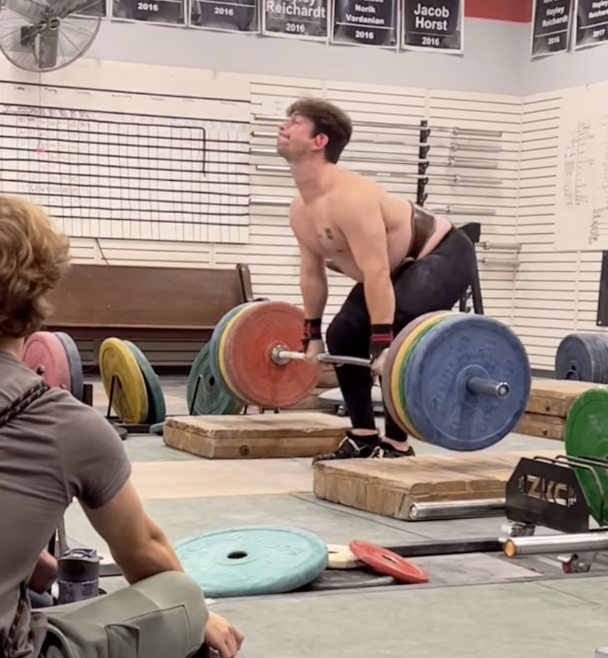Breaking Down the 6 Day Push Pull Legs Split
Written by the Boostcamp staff
6-Day Push Pull Legs: Ultimate Workout Split
If you are looking for a workout program that will help you build both size and strength, then you don't need to look any further than the 6-Day Push Pull Legs (PPL) workout split. This training routine has gained popularity among fitness enthusiasts, such as bodybuilders, and strength athletes for its effectiveness in targeting different muscle groups promoting muscle hypertrophy as well as strength, but allowing adequate time for recovery. The split divides the body into three different parts, so your workouts will follow the format listed: push day, pull day, and leg day.
The push day focuses on training the chest, shoulders, and tricep muscles. The pull day trains the back and biceps. Then the leg day trains the legs.
Let’s take a look at the guide to the 6 day push pull legs split.
Understanding the 6-Day Push Pull Legs Workout Split

The 6-day push pull legs split is a popular workout routine, typically involving a 3-day cycle where you use your push muscles on day one, pull muscles on the second day, and work your leg muscles on the third day; pretty simple. This routine alternates between high and low-intensity workouts, allowing for optimal recovery and muscle growth. The variety in exercises ensures all muscle groups are adequately stimulated and makes use of rep range to achieve desired strength and hypertrophy goals. Additionally, free weight exercises such as barbell curls and conventional deadlifts are often incorporated, making it an effective and balanced workout regime.
The Methodology Behind the Push Pull Legs Split
The 6-day push pull legs split strategically focuses on different major muscle groups each day, allowing sufficient rest time for muscles while training on consecutive days. It emphasizes compound exercises for muscle hypertrophy, optimizing training frequency for muscle growth and recovery. This split is designed to help build muscle mass by targeting specific muscle groups on push, pull, and leg days, making it an effective and efficient workout routine for fitness enthusiasts seeking muscle development.
The Popularity and Effectiveness of the Split
The push pull legs 6-day split is highly favored among fitness enthusiasts for its effectiveness in targeting the upper and lower body. With a balance of push, pull, and legs routines, it offers exceptional results for intermediate lifters and weight training. By incorporating compound movements and isolation exercises, this split proves to be an excellent way to enhance muscle size and strength. The utilization of things such as free weights, barbell curls, and leg presses within a given week's rep range makes it a comprehensive and efficient workout program.
Who Can Benefit from the Push Pull Legs Split?

Fitness enthusiasts from all levels can benefit from the versatility of the push pull legs (PPL) split. Whether you're a novice or a professional bodybuilder, the PPL split offers customizable options to suit individual fitness goals and schedules. The split allows for dedicated push and pull workouts, targeting specific muscle groups with varying rep ranges using free weights and machines. Additionally, the inclusion of leg workouts ensures a balanced and comprehensive training approach, making it the best way to train for muscle mass.
Fitness Enthusiasts
Fitness enthusiasts reap the benefits of the ppl split for muscle growth, efficient muscle hypertrophy, and fat loss. Incorporating push pull legs routine allows effective engagement of major muscle groups, promoting muscle building, weight loss, and resistance training. By optimizing the ppl split with the best exercises and workout split plan, fitness enthusiasts can achieve their training goals. Whether it’s a push workout, pull workout, or leg workout, the ppl split enables training in a given week that targets various muscle groups.
Professional Bodybuilders and the Split
Professional bodybuilders leverage the push pull legs split to achieve muscle hypertrophy, emphasizing proper form and high volume for optimal muscle growth and recovery. They tailor their push, pull, and legs routine to incorporate heavy compound lifts and adequate rest time, thus maximizing muscle mass, compound exercises, and muscle size. By customizing the push pull legs split, professional bodybuilders effectively train various muscle groups in different ways.
Novices and the Split
Engaging in a 6-day push pull legs split can be adapted by novices to suit their level of training experience and workout plan. Though this split does run the risk of overtraining for beginners, this routine offers the potential to achieve muscle growth and fat loss, making it an ideal choice for beginners. Novices can customize the push pull legs split to focus on muscle hypertrophy and building muscle mass. It's crucial for beginners to utilize proper form and rest time to maximize the effectiveness of the push pull legs workout split. By engaging major muscle groups with push, pull, and leg exercises, novices can lay a strong foundation for their fitness journey.
Pros and Cons of the 6-Day Push Pull Legs Workout Split

When following the 6-day push pull legs (PPL) split, one of the main advantages is the frequency at which each muscle group is trained, promoting significant muscle growth. With this split, individuals can include a variety of exercises and rep ranges to accommodate their preferred training style.
However, some may find it time-consuming to commit to six workouts in a given week. Additionally, the PPL split may not provide sufficient emphasis on certain muscle groups, such as rear delts and traps, which can be a drawback for those seeking a more balanced routine. While the PPL split offers flexibility, it's essential to consider whether it aligns with individual fitness goals and schedules, as shown in a systematic review and meta-analysis published by Sports Medicine.
The Advantages
With the push pull legs split, achieving muscle hypertrophy, growth, and size is attainable. This routine allows for the optimization of progressive overload and muscle recovery time between training sessions, leading to more effective workouts. Customizing the split ensures the best results for your workout program, balancing compound exercises, resistance training, and muscle mass. By utilizing this routine, heavy compound lifts, muscle building, and targeted muscle group training become more accessible. The intrinsic flexibility of this split allows for the inclusion of a variety of exercises, such as leg press, push and pull workouts, barbell curls, and conventional deadlifts.
The Disadvantages
When following a push pull legs split, much time and consecutive days of training are necessary. Customizing the routine involves high volume and rest time. It also requires a full-body workout split and heavy compound exercises. Emphasizing proper form and muscle group training is crucial. However, due to its high volume and potential for muscle hypertrophy, the push pull legs split may not be suitable for all individuals.
Diving Deep into the Push Pull Legs Intermediate Level
The intermediate level of the push pull legs split marks a significant step up in intensity. This stage introduces more compound lifts and a wider rep range to challenge muscle endurance and strength. The push workout incorporates exercises like the barbell bench press, while the pull workout focuses on movements such as rows and curls. Leg day becomes more demanding with the addition of exercises like the squat and leg press. Additionally, free weights continue to play a pivotal role in this stage, helping to build functional strength and stability.
Overview
When transitioning to the intermediate level of the push pull legs split, the focus shifts to weight training frequency, incorporating push, pull, and legs routines for muscle group training. With an emphasis on proper form, rest time, and progressive overload, this program is designed to target major muscle groups and stimulate muscle growth. Utilizing a systematic approach, it provides an effective method for building muscle and strength through its structured workout regimen. Incorporating free weights, barbell curls, and conventional deadlifts, the intermediate level offers a comprehensive approach to improving overall strength and muscle development.
Day by Day Breakdown
The intermediate level of the push pull legs split consists of a well-structured routine with a focus on upper and lower body training sessions. It combines compound movements and isolation exercises, optimizing muscle size, mass, and fat loss. With a balanced mix of push, pull, and leg workouts, it aims for muscle hypertrophy. The training sessions are designed to target different muscle groups on consecutive days, providing an effective approach for overall development. This approach allows for an efficient use of time and resources, maximizing the benefits of each given week.
What to Expect at the End of the 6-Day Push Pull Legs Split

Upon completing the 6-day push pull legs split, individuals can expect to experience significant improvements in overall strength and muscle endurance. They may also notice an increase in muscle size due to the volume and frequency of workouts, leading to great results. Furthermore, an enhanced mind-muscle connection and improved workout recovery are common outcomes. It's essential to note that individual results may vary based on factors such as adherence to the program, diet, and consistency. Additionally, understanding the importance of deloading weeks and incorporating them into the training routine will be crucial for sustained progress.
Expected Results
Anticipating muscle hypertrophy and increased muscle size is a common outcome of the 6-day push pull legs split. With a well-structured training regimen, one can expect noticeable muscle growth and enhanced strength. Setting specific goals for individual muscle groups and overall muscle size will help track progress effectively. By incorporating progressive overload and focusing on muscle hypertrophy, the expected results include significant improvements in muscle mass and strength. Emphasizing proper form and utilizing free weights during workouts can further contribute to the expected outcomes.
Evaluation and Next Steps
Regularly assessing muscle growth and size is crucial to evaluate the effectiveness of the training program. After completing the push pull legs split, it's important to thoroughly assess muscle mass and specific muscle groups. Considering adjustments for muscle hypertrophy and growth based on the progress is essential for continuous improvement. Planning next steps for the training split and workout routine is necessary to maintain progress. Reflecting on the progress of muscle hypertrophy and growth will guide the development of a comprehensive plan for future workouts.
How to Follow the 6-Day Push Pull Legs Split
When embarking on the 6-day push pull legs split, it's crucial to establish a strategic plan for each workout. Begin by organizing your training days, ensuring an adequate recovery period, and selecting the appropriate exercises for both push and pull workouts. It's also essential to define rep ranges for each exercise, to achieve a balanced routine. Furthermore, incorporating rear delts exercises and free weights into your given week is essential for variety and growth. By following this comprehensive guide, you can maximize the effectiveness of the ppl split while minimizing the risk of overtraining.
Before jumping into the push pull legs routine, it's essential to understand its dynamics. Begin by strategizing the workout split for push, pull, and leg muscles. Identify the muscle groups and their size to tailor a training split that aligns with your fitness goals. Craft a training program focusing on muscle hypertrophy and growth, ensuring an effective workout routine dedicated to muscle mass development and strengthening specific muscle groups. This preliminary phase sets the stage for a structured and goal-oriented approach to your push pull legs 6 day split routine.
Progress Monitoring and Adjustments
Consistently monitoring muscle hypertrophy and growth is crucial for optimal results. Making adjustments based on muscle size and groups is essential in the journey towards progress. Tracking muscle mass and hypertrophy plays a vital role in achieving the desired outcomes. It's important to tailor the training split according to individual muscle growth and size, ensuring a balanced approach. Continuous evaluation of muscle groups and size facilitates informed decisions, leading to effective adjustments along the way.
The Anatomy of Push, Pull, and Leg Muscles
The push muscles primarily involve the chest, shoulders, and triceps, which are targeted during a push workout. The pull muscles include the back and biceps and are worked during a pull workout. Leg muscles engage during leg day activities, such as squats and leg press. Key exercises like the barbell curl for biceps and conventional deadlift for overall strength are included. Free weights are commonly used, targeting various muscle groups. Understanding the rep range and rear delts involvement is crucial in ppl split.
Push Muscles
The push muscles primarily consist of the chest, shoulders, and triceps, playing a vital role in upper body strength and aesthetics. Key exercises for targeting push muscles include the bench press, overhead press, and dips. When engaging in push workouts, it's crucial to prioritize proper form and progressive overload to maximize effectiveness. Additionally, adequate rest and recovery are essential for injury prevention and optimal muscle gains. By incorporating free weights and focusing on the rep range, individuals can effectively stimulate push muscles within the given week, promoting overall upper body development.
Pull and Leg Muscles
Engaging in a well-structured day split like the push pull legs (ppl) split is vital for a balanced workout routine. On pull days, focusing on exercises such as barbell rows and pull-ups effectively targets the muscles of the back and biceps.
Meanwhile, incorporating leg presses and calf raises on leg days helps in strengthening the lower body, including the quads, hamstrings, glutes, and calves. Striking a balance between pull and leg workouts using free weights ensures comprehensive muscle development and overall strength. This approach ensures that different muscle groups are effectively targeted throughout the given week, creating a holistic and inclusive training program.
Finding the Best Push Pull Legs Routines
When it comes to finding some quality push pull legs workout routines, you would want to find a program that caters to your needs, gives you good accessories to do, and guides you in the right direction, making sure that you are making the most gains. If you are looking to stay on track and continue with linear progression, then finding a good workout program is the key. Where do you look for a good workout program? Check out the Boostcamp App for some great programs.
From push pull legs to upper lower, Boostcamp is home to over 50 FREE workout programs that consist of strength, hypertrophy, or functional fitness, or both. However, with Boostcamp, you don’t have to just follow a pre-written program, you also can create your own program as well, and track your progress to make sure you are on the right track. That being said, when you are looking to incorporate some arm training to further your powerlifting progress, then check out Boostcamp.
If you are not sure where to find a good program, feel free to check out the Boostcamp App! The Boostcamp App has over 50 free training programs from a variety of coaches. Programs are based around strength, hypertrophy, and so on.
Conclusion
To sum it up, the 6-day push pull legs workout split is a popular and effective approach to achieving your fitness goals. Whether you're a fitness enthusiast, professional bodybuilder, or novice, this split can benefit you in different ways. It's important, however, to consider both the advantages and disadvantages of this split before committing to it. Additionally, proper mental and physical preparation is necessary to get the most out of this program.
At the end of the 6-day push pull legs split, you can expect improved strength, muscle growth, and overall fitness. It's essential to evaluate your progress and make any necessary adjustments for continued improvement. Remember to focus on stimulating rather than annihilating your muscles and follow a well-structured program.
If you're ready to take on the challenge, we've provided a comprehensive guide to help you get started. Exploring the anatomy of push, pull, and leg muscles will also give you a better understanding of the exercises involved. Good luck on your fitness journey!
Boostcamp has plenty of free programs that help with both strength and hypertrophy, be sure to check them out and follow Boostcamp on Instagram and subscribe on YouTube!


